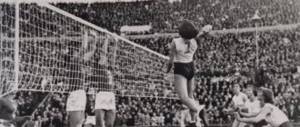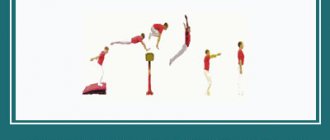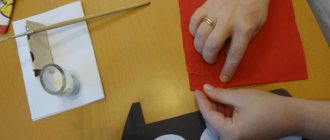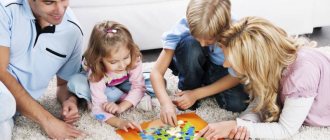Summary of educational activities for physical culture in the middle group.
Summary of GCD for physical education in the middle group
Physical education lesson in the middle group “Travel to Africa”
Author:
Evgenia Vladimirovna Vaganova, physical education instructor at MADOU No. 21 “Iskorka”, Berdsk This development is designed for children of middle preschool age and is intended for physical education instructors and teachers of preschool educational institutions.
Topic of the week: Wild animals.
Goal: To develop children's interest in physical education. Objectives: Educational:
• To consolidate the skill of climbing a gymnastic wall, walking on limited support, performing jumps with forward movement.
• Contribute to the development of agility, speed-strength qualities, and coordination abilities. • Reinforce knowledge about animals living in Africa. Wellness:
• Contribute to increasing the functional capabilities of the body.
• Prevention of poor posture and flat feet. Educational:
• Cultivate courage and respect for each other.
• Contribute to the positive emotional upliftment of children. Integration of areas: health, safety, communication, cognition, socialization, work, music, reading fiction. Preliminary work: • Drawing up a summary of the GCD on the topic. • Production of palm trees, bananas. • Sewing the “muzzle” and “tail” of a crocodile for a ribbed board. • Learning poems and riddles about African animals. • Preparation of material for musical accompaniment. Motivation: The day before, the children are informed that they will go on a trip to Africa. Materials and equipment: • Ribbed board – 1 pc., • “River” made of fabric – 2 pcs.
• “Muzzle” and “tail” of a crocodile made of fabric – 1 pc. • Log – 1 pc. • Gymnastic wall. • “Snake” • “Palm” – 8 pcs. • Toys: elephant, lion. GCD move
(duration 20 min)
Introductory part
(3 min)
Children enter the music room
• Form in a line.
Children are invited to go on a trip to Africa.
• Forming into a column one at a time using the command “Right!”
• To the musical accompaniment of “Chunga-Changa” (minus), walk around in a column one at a time. • Walking on toes, turning into normal. Children "get on" the train.
• Walking, imitating the rotating wheels of a train with your hands.
• Running, imitating the rotating wheels of a train with your hands, turning into walking.
Children move to the gym.
• Walk slowly, performing a breathing exercise (3 times), stopping at a signal.
Physical education instructor: So we came to Africa, look how interesting it is here.
Main part
(15 min)
General developmental exercises with a rope (liana) (4 min) The physical education instructor asks the children a riddle:
They love sweet bananas, They love long vines, They love to hang on a branch, They say that our ancestors!
(Tatyana Koval) Who is this? Children: Monkeys. The physical education instructor explains to the children that a liana is a long plant that looks a little like a rope, shows the children a picture of a monkey hanging on a vine and invites the children to turn into monkeys and play with the “liana.”
Children stand in a line in front of “liana”
1. “We raise the liana, we raise our necks, we strengthen our arms!”
I.p.
– basic stance, arms with the rope are lowered along the body. 1-2 – hands with the rope up, look at the rope, 4 – IP. (5 times). 2. “They put the liana down and strengthened the back.”
I.p.
– wide stance, hands with a rope pressed to the chest. 1 – tilt down, put the rope on the floor, 2 – straighten up, 3 – tilt down, take the rope in your hands, 4 – i.p. (3 times). 3. “Monkeys squat, strengthen their legs.”
I.p.
– basic stance, hands with a rope (overhand grip) pressed to the chest. 1 – squat on your toes, knees to the sides, place the rope on the floor, 2 – straighten up, 3 – squat on your toes, knees to the sides, take the rope in your hands (overhand grip), 4 – i.p. (3 times). 4. “Monkeys warm their heels.”
I.p.
– lying on your back, legs on your feet, hands with a rope pressed to your chest. 1 – raise straight arms and legs up; 2 – i.p. (4 times). 5. “Nimble monkeys”
Running in a column one at a time, “liana” in the right hand (overhead grip), turning into walking, then stopping at a signal.
“We walk on the vine - we strengthen our feet.” Walking on a tightrope (20 seconds). 7. Breathing exercise “Tarzan”.
I.p.
– stand with legs apart. 1 – arms with external arcs up – inhale; 2 – “beat the chest with fists” – exhale, pronouncing the sound (a) (3 times). Basic types of movements (7 min)
The monkeys go into the jungle.
1. Balance. Children meet a crocodile lying across the river.
A log lies across another river. The physical education instructor asks a riddle: A log floats down the river, Oh, how angry it is! Those who fall into the river will have their Nose bitten off... (Crocodile) (Serova E.) While “the crocodile is sleeping, the children walk along it one after another, then along the log, arms to the sides.
2. Climbing. Children, having completed the task, approach the gymnastic wall - the “banana tree.” Physical education instructor: They grow high, And it’s hard to reach them. They love monkeys very much, these yellow ones... (S. Kurdyukov) Children: Bananas. The physical education instructor invites the “monkey” children to show how they can climb trees. Before the children begin to complete the task, clarify that the grip on the bar is from above.
Children climb up the gymnastic wall and then climb down.
Outdoor game “Elephant Dance” (3 min) Children approach the elephant, line up around it and turn into baby elephants. Physical education instructor: Once upon a time, elephants were dancing in the jungle. Imagine what happened in the jungle! Children turn one after another and perform the movements in accordance with the text: The elephants stamped their feet: Top, top, top, top. They jumped one after another: Jump, jump, jump, jump. Jump, jump, jump, jump. And they shook their tails: Jerky, twitch, twitch (They repeat it a second time in the opposite direction)
But suddenly they met a snake, And they quickly ran away...
(Running in a column, one by one, around, turning into walking, stopping at a certain place).
Children-"elephants" stand around the snake, pretending that they are lion cubs.
Breathing exercise “Lion” I.p.
– stand with legs apart. 1 – arms with external arcs up – inhale; 2 – spreading your “claw” fingers in front of you – exhale, pronouncing the sound (r) (3 times) Final part
(2 min)
Sedentary game “Flexible Snake” Having realized that the snake was not afraid of them, the children turn into one big snake: they stand in a column one at a time, placing their hands on each other’s shoulders. Then they walk between the “palm trees”, depicting a crawling snake.
The "snake" crawls out of the jungle and turns back into girls and boys. The children stand in a circle, the physical education instructor says that the journey is over, invites the children to remember who they met during the journey, and what difficulties they had to overcome. Then the physical education instructor gives the children stickers of animals living in Africa. Methodical instructions: • When a child gets off the log, he first gives his hand to the child next to him, helping him get off the log, and then steps aside. • Mandatory insurance for children while walking on a balance beam and climbing a gymnastic wall. • Monitor the take-off and landing technique when performing forward jumps. • Monitor movement coordination while walking and running. • Constant control of posture. • When performing breathing exercises, exhalation is longer than inhalation. • If there is no long rope, and only short ones (1.5 m) are available, then during the outdoor switchgear exercise the children can be divided into two groups.
We recommend watching:
Summary of educational activities in the middle group “Mushroom Glade” Physical educational leisure for children of the junior and middle groups. Journey to the forest Physical education classes in the middle group A plot-based physical education lesson in the middle group. Abstract
Similar articles:
Lesson summary for the middle group: Safety at home
Summary of a lesson in kindergarten “Receiving guests.” Middle group
Lesson summary for the middle group on the topic: Properties of glass
Lesson in the middle group of kindergarten. Village courtyard
Summary of a lesson on cognitive development in the senior group. Rules of conduct in the circus
Middle group. Junior preschool age. Children 4 - 5 years old
Summary of physical education and recreational leisure activities with children 3–4 years old “Autumn Adventures” Goal: - creating conditions for children’s physical activity. Objectives: - practice jumping with advancement; run like a snake; - develop coordination of movements, dexterity, creative imagination; - cultivate a caring attitude towards nature and each other. Materials and equipment: -…
Physical education entertainment “Journey to Sportlandia” for parents and children of the middle group Objectives: 1. Improve various types of walking, forming correct posture and developing general coordination of movements. 2. Train children to run at different paces. 3. Practice maintaining balance. 4. Learn to jump rope, pushing off vigorously and landing softly with...
Methodology for conducting open physical education classes
The structure of a demonstration lesson is no different from the composition of a regular one. The only difference is that when preparing an open lesson, the teacher introduces the children in advance to the nature of the tasks and practices their implementation using similar material. This is done so that the picture of an open lesson is not distorted by organizational shortcomings, when children (who are still completely inexperienced in this type of lesson) do not know where to stand, how to turn, how to start completing a task.
Time plan
Physical education lessons are held three times a week: two of them in the gym or in a group, and one on the street, if, of course, the weather conditions are favorable for this. Usually, unless there are special instructions, an open lesson is held indoors.
In the average group, the lesson lasts 20–25 minutes. Timing allows you to consider the topic of the lesson, regardless of whether it is open or regular, in three stages:
- introductory - up to 6 minutes (the teacher motivates the children to work, gives them tasks to strengthen the musculoskeletal system);
- mostly - 15 minutes (ORV tasks, breathing exercises, tasks for practicing movements, as well as outdoor games);
- final - up to 4 minutes (kids recover from physical activity with the help of sedentary play and slow walking).
The completion of each exercise must necessarily fit into the time frame of the stages of the lesson.
Table: Moleva M.A. summary of an open physical education lesson on the topic “In search of adventure” in the middle group (fragment)
| Stage | Content |
| Introductory | - Hello guys! You recognized me? (the teacher enters dressed as the pirate Jack Sparrow) I am the main pirate - Jack Sparrow. I have a big, beautiful ship. Look. (the ship is built from modules). It's called Pearl. |
| Jack: I have a secret. I found a map, it shows the place where treasures are hidden, many, many treasures. Look: everything is marked here. Would you like to go on a treasure hunt with me? (yes).. Get on my ship and go. (the music of the sea sounds - the daytime sound of the surf)…> | |
| “You and I will board the ship and set off on a distant, mysterious journey full of dangers, but first we need to warm up a little.” Walking “We walk along the shore” - normal walking (20 sec) - Guys, let’s imagine that there is “hot sand” here and you need to walk on your toes, arms up. (20 sec) - And then “sharp stones” - walking on your heels, hands on your waist. (20 sec) - Suddenly we have to run away from a pack of “predatory animals - running. (30 sec) Walking, breathing exercises (20 sec). Well done guys, I think you are ready to hit the road...> | |
| Basic | We board my ship, and first of all we raise the sails (the music “Chunga-Changa” from the movie “Katerok” sounds) Exercise “Raise the Sails”
- Well done, our sails are ready to set off on a long journey. What is this? It seems that our ship has begun to rock. (Standing on a gymnastic mat, hands on the belt) |
| — We look at the map, what we need to do. There is hot sand ahead, so as not to burn your feet, you need to jump on two legs like this: jumping from hoop to hoop, moving forward, a distance of 3 m (5-6 hoops). — Let's look at the map, what is drawn? You need to hit the target with a coconut. Look how many coconuts are scattered here. (throwing balls at a target from a distance of 1.5 meters using the method from below)...> <... - Now we have a cave in front of us, which we need to get into in different ways, since the cave is getting narrower. Climbing through gates of different heights (gates of different heights). - Wow! What rocks and a big cliff there are. To overcome this cliff, you need to crawl along a log. (crawling on a gymnastic bench on your stomach, pulling yourself up with both hands, gripping your hands from the sides)…> | |
| <... Outdoor game “Sharks” Progress of the game: Children are divided into two unequal groups: 2-3 “sharks” and “sailors”. On a large ship made of modules, there is a “captain” (educator). He watches the "sailors" swimming in the sea. Children run around the hall, spreading their arms, as if swimming. "Sharks!" - shouts the “captain”. The “sailors” quickly board the ship, and the “sharks” rush after them. Having not caught anyone or, conversely, having taken their prey, the “sharks” swim away into the sea, and the “sailors” jump into the sea again, swim and dive. Rules of the game: Catch only after the word “sharks!” Sharks are not allowed to enter the ship. Those caught are taken aside and miss one game...> | |
| - Hurray, we found treasures, so many of them. And now, before it gets dark, it’s time for us to go back to kindergarten. We go on the ship. Let's go. Here we are in kindergarten. Did you enjoy traveling? — Thank you guys for your help in finding the treasure. Thank you for your attention! |
Video: open physical education lesson in the middle group - exercises with balls
Types of exercises in physical education classes in the middle group
Based on the objectives of physical education development in middle preschool age, in the classroom the teacher combines the following types of exercises:
- to practice the speed and direction of running and jumping;
- for orientation in a limited space of a site or room (this also includes tasks for building and rebuilding);
- for balance;
- for imitation;
- to train climbing skills (mostly these are tasks on the gymnastic wall);
- ball exercises;
- to develop attention;
- relaxation (that is, games of low mobility or slow movements of the arms and legs while lying down or sitting).
The most productive way to explain and attract children to perform exercises is through a game. You can see examples of outdoor games here.
Play is the main form of organizing work with children





